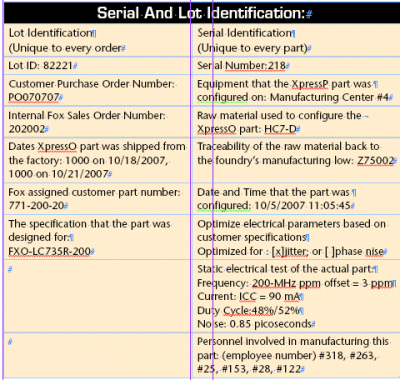Serial identification of frequency control parts
A simple solution for an advanced technology
BY LEROY SUTTER
Fox Electronics
Fort Myers, FL
http://www.foxonline.com
As technologies within the frequency control industry continue to advance, the process of manufacturing high-tech components has become technically demanding, calling upon the need for greater accuracy and increased quality control procedures. As customer demands for high-tech products are on the rise, countless manufacturers have not updated their quality control procedures to compliment these products, which increases their risk of producing faulty components.

In the past, a quality control procedure may have entailed a manufacturer assigning an actual person to the task of measuring parts, recording them on a piece of paper, and keying them into a dedicated program for analysis. This dated process had many drawbacks including its slow and tedious nature as well as an increased risk for inaccuracy due to human error.
Today, automating quality control makes for a far more efficient, accurate process that uses data collection equipment to automatically enter the information into a datalogger. In addition, automating data control removes the possibility of human error and allows for quick analysis of a product line, should problems arise once the product reaches the customer.
When a component manufacturer receives that dreaded phone call from a customer whose component has failed, the manufacturer typically asks the customer to refer to a purchase order, a sales order, or a lot number to identify the part and lot from which it came. The customer usually comes up empty handed, resulting in the manufacturer being unable to provide any useful data on the lot of parts that was brought to attention, leaving both the manufacturer and the customer with many unanswered questions, such as is there just one bad component in the lot, a few, or even all?
The best defense is a good offense
With billions of products produced every day, quality control procedures should be continually updated, especially for electronic component manufacturers, whose products require more detailed manufacturing. Even the very best component manufacturers will, at some point, produce a faulty component. When this happens, it is essential that the customer has a means of knowing all of the production details from the manufacturer of the component, so the manufacturer can maintain the customer’s confidence. This level of data traceability has been almost nonexistent within the frequency control industry until now.

Thanks to a new serial identification system used in the production of oscillators, accountability for quality control has increased considerably within the frequency control industry. This system not only gives users manufacturing data previously unavailable, but enables the manufacturer to provide the information within a few hours of receiving the defective part. For example, this capability is featured in Fox Electronics’ configurable high-performance low-cost XpressO oscillator series.
Identifying the problem
As frequency control components continue to advance technologically, the physical parts themselves keep getting smaller and smaller. With the use of a serial identification system, the serial ID number is conveniently embedded into the part’s nonvolatile memory.
The oscillator’s internal serial ID number identifies the component’s date and time of production and who was involved during the manufacturing process at the facility. It also identifies the raw materials used to manufacture a specific oscillator and what electrical tests were performed on the completed oscillator. Any optimized electrical parameters included, based on customer specifications, are also available through the serial ID.
In addition, for easy reference, each product features a lot number, which ties directly to the user’s purchase order, marked on the reel label as well as internally on the part’s non-volatile memory. The lot number facilitates quick identification of an oscillator shipment by providing the user’s purchase order number, the manufacturer’s internal sales order number, the date the part was shipped from the factory, the assigned customer part number and the specification for which the part was designed.
Now, customers are afforded a deeper sense of confidence in product performance and reliability, since issues and problems can be traced back to a specific source within the manufacturing process. This is a far cry from scrambling for a purchase order only to find out that the information is not even accessible.
Conventional oscillators are not good candidates for this program due to their lack of nonvolatile memory. In addition, conventional oscillators can be traced with the use of hard copy data only, which includes frequency and lot codes, a PO number or an order date.
Due to the lack of traceability, locating production details of conventional oscillators is a rather lengthy process and it is recommended that users purchase oscillators featuring the new serial ID program to obtain the information they are entitled to within a timely manner. As the industry continues to move in this direction, traceability will no longer be an issue because all oscillators will offer this system as a standard feature.
Satisfaction guaranteed
If an oscillator with serial ID should fail, the faulty component is simply shipped back to the manufacturer for data extraction. The level of detail provided by each unique serial identification number provides the user with the kind of production data resolution needed to determine if just one faulty component was shipped or possibly more. This data tracking system provides the user with a far higher degree of confidence concerning its risk and exposure to faulty products.
In fact, when a company receives a faulty component, it is often discovered that the part was not even manufactured by the company. This demonstrates how prevalent this problem is within the frequency control industry and how important it is to update quality control procedures with a serial identification system, so manufacturers will be able to better identify their components and have greater traceability of its manufacturing lots.
Simplest of solutions
The main idea behind any quality control procedure is to offer some guarantee of consistency and quality among products as well as accountability for problems. For any company, the ultimate goal should be continual improvement of quality to give customers a better product.
The first step in achieving this goal is to have as much information as possible readily available at the customers’ disposal. This will not only portray the manufacturer’s high level of confidence in its products, but will transfer that level of confidence to its customers. What better way for component manufacturers to highlight this level of quality assurance than with an identification system so precise that nearly every detail about a product can be revealed just by reading a simple number. ■
Advertisement
Learn more about Fox Electronics





